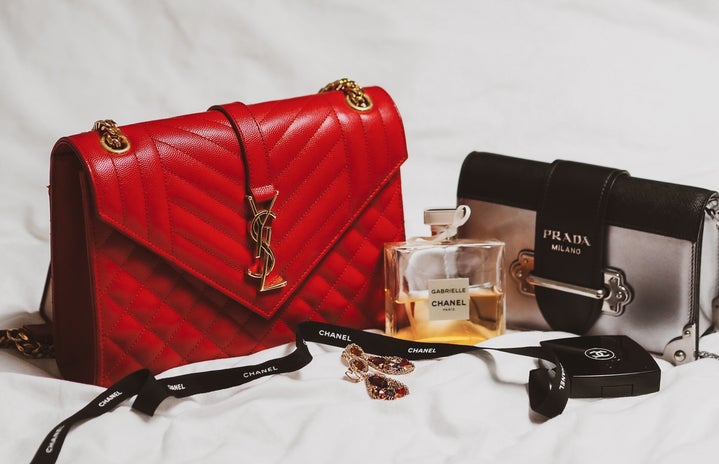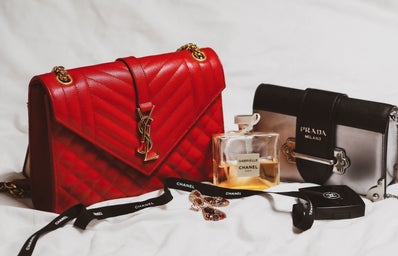When buying designer, it’s hard to tell if you’re making the right choice, especially with all the dollar signs in your face that are often attached to these collections. Many people aspire to have a Carrie Bradshaw-esque closet, filled to the brim with different designer collections. While this is certainly fun to think about, it’s much more important to fill your collection with pieces you truly love, that truly reflect your style, and that will get lots of wear.
I like to think of buying designer like getting a tattoo. It’s something that’ll likely cost a lot of money, be with you for a very long time, and should reflect something about yourself.
Price per wear
To help you think about buying ethically, I want to talk about the “price-per-wear” of an item. Designer products can often come with a hefty price tag, and this can be daunting when choosing whether or not to buy an item. Price-per-wear is the idea and formula that’s used to determine if an item is worth it or not. Here’s how to calculate its worth.
First, determine what you’d like your ideal price-per-wear to be for a certain item, bearing in mind that things like party dresses will tend to have a higher price-per-wear than shoes or a coat.
From deciding that ideal price-per-wear, take the total cost of the item you’re thinking of buying. Let’s say this is a nice coat from a small designer that costs $700. That price would make anyone sweat, but let’s assume that this is a well-made coat that should last you at least 10 years. You live somewhere with all four seasons so you’ll get about four months of wear from it.
Do you plan on wearing this coat daily? On special occasions? Most days? Here, you can estimate how many times you’ll wear the coat a year, and then multiply by the shorter end of its lifespan. Let’s say you’ll wear this coat half the time in the winter, so about 60 days a year. Multiply this by 10 years and you get about 600 wears.
Divide the price by the number of times worn to see that: it costs about $1.17 per wear. This is much cheaper per-wear than a $100 coat made with less quality that’ll only last you a season. Using this method will help you see the item in a broader perspective, and will help you choose well-made items that will fit your style for a long time.
In this price-per-wear model, there are a lot of moving parts that I want to touch on a bit more deeply.
First, there’s the idea that different kinds of items will have different price-per-wears. A pair of fancy heels you wear a few times will intrinsically cost more per wear than a t-shirt you wear once a week. This is okay. Not every item will be close to a dollar for each wear, but that doesn’t mean each item isn’t loved. By nature, party dresses will be worn less often than slacks, shoes, or coats.
It’s just the way the cookie crumbles and as long as all the items you wear are likely to fit your style for years to come, it’s still more ethical than always buying things you’ll only wear for a season, or even just one time.
In the same vein, very few socks, bras, and underwear will last more than a few years, at least in my experience. These things are best to splurge a bit on for quality, but I wouldn’t personally spend designer prices on these items, just because of their shorter lifespan.
Fast fashion
As we all know and also all like to ignore (hey, I’m guilty of it, too), fast fashion is one of the largest contributors to pollution. If we can all get better at buying clothing we will love for a long time that are made well enough to love for a long time, that will lessen this issue.
This also has a necessary caveat. Obviously, one of the biggest problems with shopping sustainably is that it’s not always possible for everyone. It is more money upfront to buy nice things to last, and price-per-wear doesn’t take the little chunk of money out of your account for each wear, it still requires you make that initial scary investment. This article is in no way here to shame people who are not able to make changes like the ones I talk about, but to encourage thoughtful behaviors when you’re able to.
I also touched on making sure the item you spend a lot of money and thought on will fit your style for years to come. By no means do I want you to only buy solid-colored things, basic silhouettes, and only safe items, but I do want these items to fit your personal style.
It’s really easy to see a handbag that Kylie Jenner wears, “ooh” and “aah” at it, and want to buy it. I like to take items like this out of context to think about, because it is possible that they fit your personal style, but it’s also all-too-easy to idealize celebrities and their lifestyle and equate their items to how you think they feel. Additionally, sometimes the high price tag is nice because in the time spent saving up for the item, you get past the saturation of the trend, allowing you to think about if you really want the item.
By not buying trends just to buy them or post a photo with them for your Instagram, you allow yourself to have a dynamic and unique closet that is timeless to you. This brings me into a personal rant of mine: people often only call the “Cool French Girl” aesthetic timeless, when it’s just the most simple. Timeless style has much more to do with how you style items if they are true to who you are throughout time, and how you feel and present yourself in them. Everyone on planet Earth will look more timeless in an outfit they love than in a simple outfit they hate.
If you do want to try out something outside your personal style while building your designer collection, because we all need those little fun pieces that are different from our regular look, I suggest buying second hand. This way you are not directly contributing to the rapid trend cycle brands feed off of.
Rather, by not telling brands you will buy the next it item as long as they tell you it’s what you need, and instead pulling an item from the shelves that may have gone to the landfill otherwise, you are staying fashionable without harming the planet. Not only is it better for the environment, but it is also usually better for your wallet. Second hand items tend to have a lower cost due to wear, trends, condition, and age. This means that if you wear the item often, it will likely have a lower cost-per-wear.
BUILDING YOUR COLLECTION
When I think about my future designer collection, I like to seek inspiration from one of my favorite TikTokers, Carla Rockmore. Not only is her collection just massive and everything I dream about, but she has thrifted, gotten passed down, or even designed much of it. In many of her getting ready videos, she puts on items and talks about how she’d had them for 20+ years. I just love how she has let her style evolve with her by finding new ways to wear items she’s loved for such a long time.
She really speaks to me for being so bold in her outfits, always looking for new ways to wear things, and styling items outside their obvious aesthetic. These are all great ways to wear items you have that no longer fit the style you imagined when you bought them. As hard as we try, it can be quite difficult to know if you’ll still like something in 10 years, but she shows me that it’s not about having hard rules for yourself in how something should look.
Buying designer can feel really overwhelming if you don’t know what items to spend your hard-earned money on, but by using some of the techniques I mentioned in this article and being a more thoughtful consumer, it doesn’t have to be. Building your designer collection should be really fun and exciting, knowing you may have these clothes for the rest of your life, so choose wisely!


